It’s hard to argue with chicken tikka masala, so universally appealing is its marriage of a favorite meat with a subtly spiced, tomatoey cream sauce. There’s hardly an Indian restaurant in existence that doesn’t serve it, but here’s an inconvenient truth: It’s not Indian. (It was invented in the U.K. in the latter half of the 20th century.)
And here’s another shocker: There is no single Indian cuisine. The subcontinent is huge, after all: The two largest countries on it, India and Pakistan, have a combined area of 1.6 million square miles—about the same size as the European Union. The landmass comes with a wide range of climates and topography, diverse histories of migration and conquest and two major religions, Hinduism and Islam, each with its own dietary restrictions.
This is not to say that most of the items on your local Indian restaurant’s menu aren’t “real.” But most of the greatest hits —think tandoori chicken, rogan josh, aloo ghobi, samosa — originate in the North and are just a small part of a rich culinary tapestry of regional foodways. And here on Long Island, diners seeking to explore them have a secret weapon: Hicksville.
In the last 20 years, Hicksville has become an epicenter of Indian and Pakistani restaurants: Scores of them line a two-mile stretch of Broadway and pepper the side streets. And they represent many, though not nearly all, of the cuisines eaten by 20 percent of the world’s people.
Take that of Hyderabad, a city in south-central India. One particular glory of Hyderabadi food is the rice dish called biryani. “It’s the ultimate celebration food and people plan events just as an excuse to make it,” said Abdul Salam Mohammed, chef-partner at year-old Jazeera, which specializes in Hyderabadi cooking. A civil engineer by training, he immigrated to New York City in 1998 and took a job with the New York Housing Authority. “But I was the guy everyone asked to make biryani and, eventually, my partners said, ‘We’ll open the restaurant, you just make the food.’ ”
Biryani shows up on most South Asian menus, but Mohammed’s is exceptional, the result of his labor-intensive, exacting method. He seasons chicken, goat or mixed vegetables with cardamom pods, cloves, cumin seeds, turmeric, cinnamon sticks, cilantro and mint leaves, garlic, green chili paste, red chili powder, salt, fried onions, lemon juice, yogurt, salt and his own garam masala. (Cooks typically create their own spice blend to lend their dishes a unique taste.)
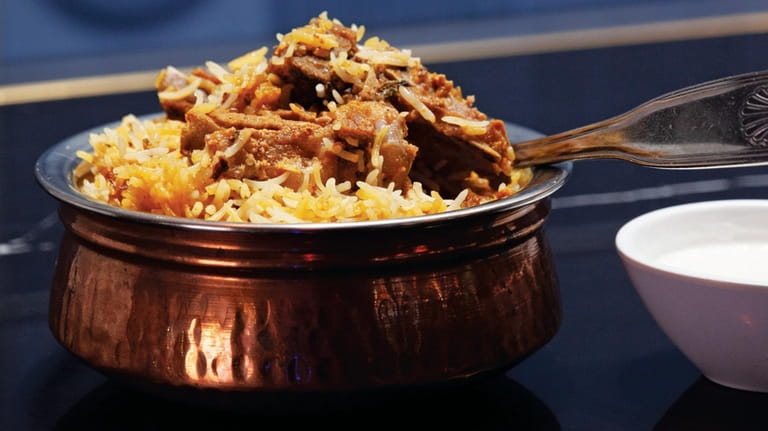
Mutton biryani at Jazeera in Hicksville. Credit: Stephanie Foley
Meanwhile, basmati rice is simmering in water liberally seasoned with the same aromatics. The meat (or vegetables) is transferred to a deg, a large heavy pot with a wide base and narrow neck. When the rice is about 40 percent cooked, Mohammed scoops a portion of it into the deg. When the rice is a little more cooked, he adds another layer and so on until all the rice is used. (The idea is that the rice closer to the bottom will cook more quickly than the rice on the top, so this ensures that everything is done at the same time.) Unlike pilaf, paella or risotto, no liquid is added to the deg—its narrow neck encourages steam to condense and keep everything moist. The finished dish sings with the distinct flavors of its myriad ingredients but, Mohammed noted, “The secret is balance and proportion. Nothing dominates.”
There is chicken tikka masala on Jazeera’s menu, but Mohammed encourages diners to order dum ka murgh instead. Like chicken tikka, chunks of the bird are enrobed in a creamy sauce, but the sauce, rich with ground cashews and sautéed onions, is more intricate. Among the other Hyderabadi specialties that might catch your eye are the samosa-like kheema lukhmi, for instance, or haleem—a savory porridge of cracked wheat and goat garnished with cashews and musky, citrusy curry leaves—and double ka meetha, a terrific cardamom-saffron bread pudding accompanied by stewed apricots.
There’s no better demonstration of Hicksville-as-microcosm than the presence, next door to Jazeera, of Taste of Chennai. In India, the journey from Hyderabad to Chennai (formerly Madras) would be 400 miles; here, it’s a mere six steps.
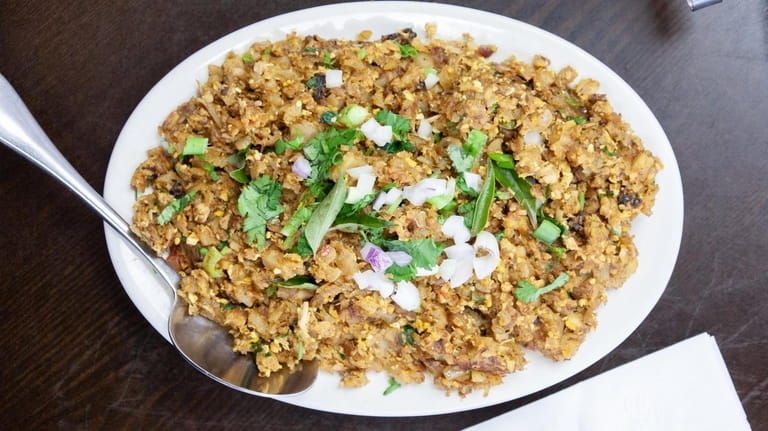
Kothu Parotta with chicken at Taste of Chennai in Hicksville. Credit: Stephanie Foley
Murugan Gounder, chef-owner of Taste of Chennai, worked at luxury hotel restaurants in India before moving to the United States in 2006. After 14 years of cooking in Manhattan, he set off on his own. “Most of the other South Indian restaurants on Long Island are vegetarian,” he said. “I wanted to present the full range.”
His menu showcases dishes from India’s four southernmost states, Tamil Nadu (of which Chennai is the capital), and its neighbors, Andhra Pradesh, Kerala and Karnataka. All have long coastlines, so it’s not surprising that seafood is an important element of the menu. One of the best-loved Indian Ocean fish is kingfish, which Gounder turns into a mean meen kuzhambu. The fish’s meaty, white flesh is a fine counterpart to a lush, vividly spiced sauce punctuated by tiny black mustard seeds.
Cream is not a common ingredient in the South—coconut does most of the creamy lifting, driving dishes such as crab masala curry, made with Atlantic blue crabs. “They are not the same crabs as we have in India,” said Gounder’s wife, Jothi. “But they are very similar.” Anyone who grew up in Maryland (as I did) will appreciate the affinity between blue crabs and spice. But where Terrapins take on their crabs with a mallet, Taste of Chennai offers a pair of curved-blade scissors that do a better job.
The most dramatic seafood dish on the menu, meen pollichathu, has no sauce at all: Cross-cut steaks of well-seasoned pomfret—a sweet, mild fish—come wrapped in a thin band of banana leaf. You’ll want to make sure you get every bit of meat off the bones.
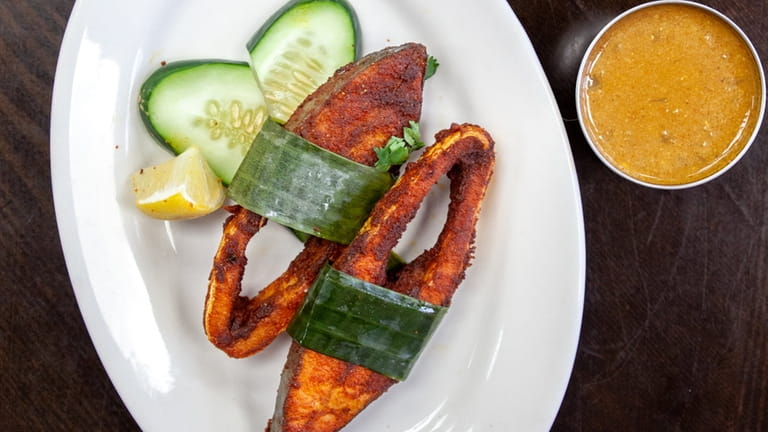
Meen Pollichathu; Pomfret wrapped in banana leaves at Taste of Chennaiin Hicksville. Credit: Stephanie Foley
The origins of so many Indian dishes are shrouded in the mists of time—brought over the mountains by invading Moghuls, invented at the court of this or that rajah or nawab—but one of Chennai’s most famous, Chicken 65, has been traced decisively to A.M. Buhari of the Buhari Hotel. After that, however, the details get hazy. Was the dish invented in 1965? Made with 65 chilies? Gounder’s son, Naveen, heard tell that its heat level was supposed to be 65 out of 100.
It is, however, indisputably delicious. At Taste of Chennai, boneless chunks of chicken, redolent of ginger, garlic, red chili and cumin, are dropped into hot oil, emerging with a delicate veil of crimson spice that is hot enough to give you a little kick. “In movies, people are always sitting at the bar, eating Chicken 65 with a drink,” Naveen said.
Taste of Chennai does not shy away from South India’s vegetable dishes, but if you want to sample a fuller panoply, pay a visit to the House of Dosas, 100 percent vegetarian, predominantly vegan and, at almost 27 years old, one of Long Island’s most venerable Indian restaurants.
Owner Jay Jeyasri is from Sri Lanka but his wife, Selvi, is from Tirunelveli, close to India’s southernmost tip. “Even without meat, there is so much variety in our cooking,” she said. A daily thali meal—in which assorted vegetarian curries are served on a platter with rice and bread—makes sampling easy.
There is tremendous diversity, too, in the restaurant’s eponymous dish. The dosa is a huge, griddled crepe—crisp on one side, porous on the other—made from a fermented batter of rice and lentils. Paper dosas are superthin and even bigger than the regular ones. Any dosa described as “masala” is folded around a heap of silken potatoes mashed with onions and spices. Rava dosas are made with a wheat-rice batter that is not spread evenly onto the griddle but drizzled on, Jackson Pollock–style. Idly are made from dosa batter but formed into small nuggets and steamed.
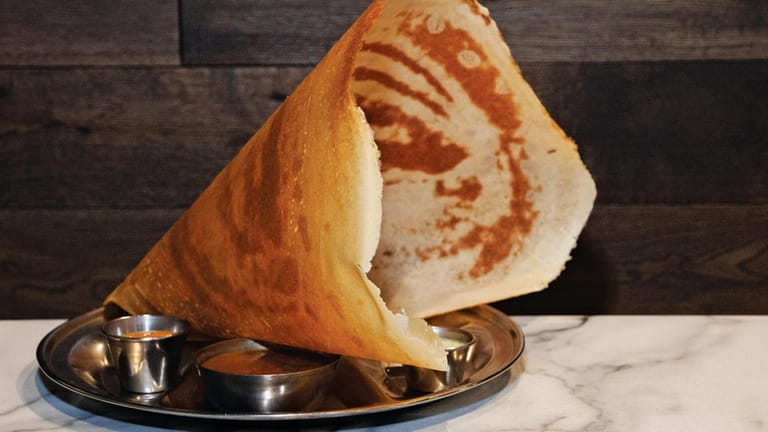
Paper masala dosa filled with potato and served with vegetable soup and coconut chutneys at House of Dosas in Hicksville. Credit: Stephanie Foley
Rice is the dominant grain in South India and most people there eat short-grain varieties. The renowned long-grain variety, basmati, grown in the North, is very expensive—typically, it’s saved for special occasions—and most of it is exported. But here in the United States, Selvi said, “even Southern restaurants serve it.” At House of Dosas, one glorious use for basmati is lemon rice, a fragrant, golden bowlful.
And now, a big leap from South India to Karachi, Pakistan, 1,700 miles northwest. Or, this being Hicksville, Kababjees, just down the street. There was a time not so long ago when most Pakistani-owned restaurants on Long Island identified themselves as Indian. There’s historical justification for the fudge: When India, a British colony, gained independence in 1947, it was partitioned into two new sovereign nations, majority-Hindu India and majority-Muslim Pakistan. The already-existing cultures and cuisines predated the new political boundary by millennia. But when Faisel Ejaz opened Kababjees in 2017, he made his background clear. “I saw many other Pakistanis operating so-called Indian restaurants,” he recalled. “I wanted to be straight about where I am from.”
On its sign, Kababjees categorizes itself as “BBQ Experts,” and the menu lists dozens of grilled skewered meats from tikkas (boneless pieces) to seekhs and golas (ground meat) that arrive on platters or rolled up in flatbreads.
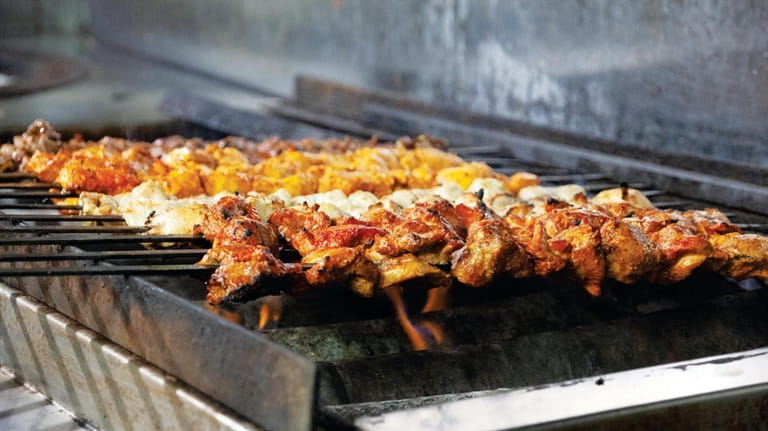
Beef Gola kebabs at Kebabjees Pakistani Restaurant in Hicksville. Credit: Stephanie Foley
The menu at Kababjees lists many chicken, lamb and mutton dishes. Wait, some of you may be saying. Isn’t mutton just mature lamb? Indeed, it is, but at most South Asian restaurants, “mutton” means goat. Apparently, during British rule, the subcontinent’s butcher shops were called “mutton shops” and the word became identified with goat—mild, lean and the more popular of the two meats.
Ejaz is definitely on Team Goat, and the most popular dish at Kababjees is his goat karahi, named for the heavy iron pot in which it is cooked and served. It’s flavorful and succulent, the king of Kababjees’ menu. The queen? That would be chicken charga, a whole chicken roasted in the tandoor oven.
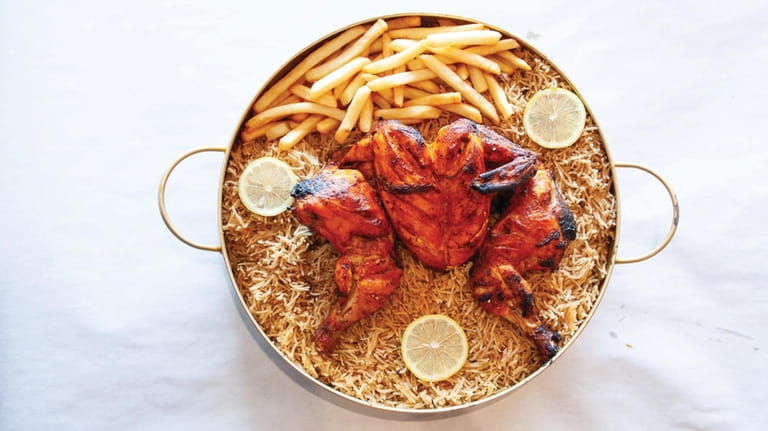
Tandoori charga at Kebabjees in Hicksville. Credit: Stephanie Foley
The barrel-shaped clay tandoor, seen all over South and Central Asia, is used to cook meats and the flatbread called naan, probably the best known of the South Asian breads. They’re all traditionally cooked either in a tandoor, on a flat griddle (chapati, roti, paratha) or in a deep fryer (puri, bhatura). When the Portuguese established a colony on India’s west coast in the 16th century, they introduced oven-baked breads and that influence lives on in pav—a fluffy bun that often accompanies street foods.
At Taste of Mumbai, a pav could be mistaken for a Parker House roll. Chef-owner Joyal Gonsalves has the buns made at a bakery to his specifications and deploys them in a few starters, including pav bhaji, a vegetable curry, and vada pav, in which a potato fritter is sandwiched in one. Because this is a sit-down restaurant, Gonsalves plates the pav with all the go-withs—chopped onion, lime wedges, chutneys and raitas—but on the street in Mumbai (formerly Bombay), the customer would direct the garnishing in the manner of Chipotle.
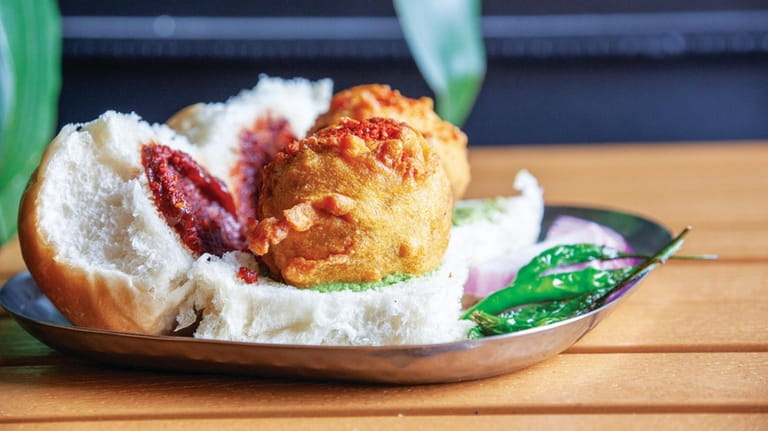
Vada Pav, fried potato with chutney at Taste Of Mumbai in Hicksville. Credit: Stephanie Foley
Gonsalves trained as a chef in India and spent 12 years at Mint in Garden City before opening his place last year. “A lot of restaurants here serve the food of North and South India,” he said, “but I didn’t see anyone serving the food of the West.”
Taste of Mumbai earns its plant-based bona fides with a bang-up yellow dal. “Dal” is the Hindi word for the dried legumes (beans, peas, lentils) that, along with rice, lie at the very heart of Indian food. Gonsalves uses red lentils and split mung beans in his yellow tadka dal, and that middle word is key. It describes a tempering technique that involves cooking seasonings in hot oil or ghee very quickly, allowing the spices to “bloom.” When the sizzling mixture is added at the end of cooking, it adds extra richness and brightness. “It gives it that spark of flavor,” Gonsalves explained.
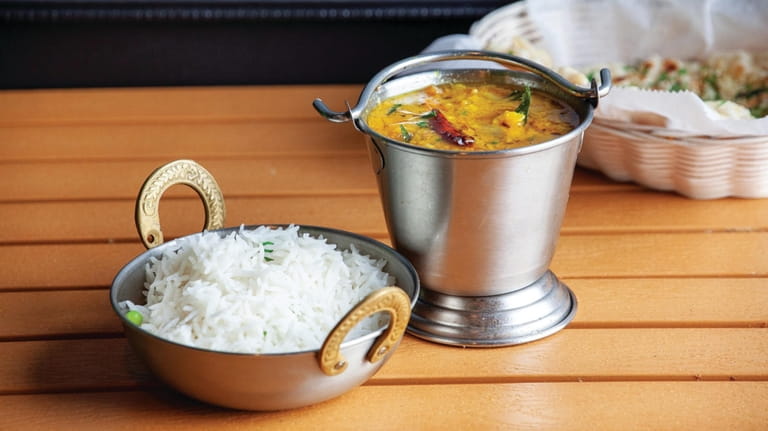
Takka Daal, yellow lentils toasted in sizzling ghee at Taste Of Mumbai in Hicksville. Credit: Stephanie Foley
After a parade of complex, deeply flavored dishes, dessert may feel like an afterthought, but don’t be fooled. Sweets (mithai) are an important part of the Indian culinary landscape, and although every restaurant will serve a few, sometimes it pays to visit a specialist. Since 2002, Bengali Sweet Shop has been making, in addition to vegetarian fare, a dizzying array of mithai—they may be fried or baked, decorated with gold or silver leaf, fragrant with spices or rosewater. “The name ‘Bengali’ connotes the best sweets,” said the shop’s owner, Raj Kumar. “It’s like when you say, ‘French pastry.’ Everyone knows that that is the best.”
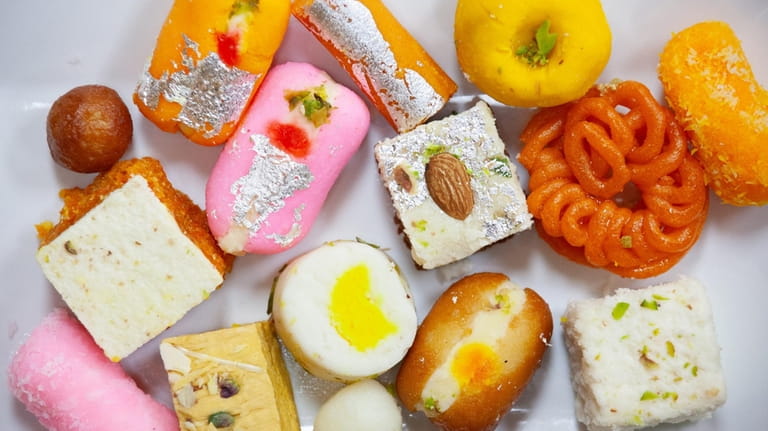
A range of desserts at Bengali Sweet Shop in Hicksville. Credit: Stephanie Foley
Kumar’s family is from North India and most of his savory dishes reflect that. Northern vegetarian food is heartier than that of the South, and here he singled out chickpea stew (chole bhature), “a go-to Punjabi dish,” which is accompanied by a giant orb of hollow deep-fried bread. Or saag paneer, fresh cheese smothered in spinach and mustard greens. One part of his menu is devoted to paratha (or parantha), a griddled whole-wheat flatbread filled with everything from potatoes and cauliflower to fenugreek leaves, which have an edgy funkiness.
Before Kumar launched the sweet shop, he owned a grocery store at the same location. When it opened, in 1987, he recalled, “There were no Indian or Pakistani restaurants in Hicksville.” He is amazed at the scene that has unfolded since then. “The restaurants here bring people from all over Long Island,” he said. And not only does the town provide a delicious education for Americans with no connection to South Asia, but he also believes it serves a valuable service for South Asians themselves. “It used to be that if you were from a part of India or Pakistan, you went to the restaurant that served that food. But now I see everybody wanting to experiment with cooking from all over.”
Restaurant information
BENGALI SWEET SHOP 343 S. Broadway; 516-935-3391, bengalisweetshicksville.com
HOUSE OF DOSAS 416 S. Broadway; 516-938-7517
JAZEERA 37 W. John St.; 631-229-3646, jazeerahicksville.com
KABABJEES 495 S. Broadway; 516-597-5777, kababjeesny.net
TASTE OF CHENNAI 39 W. John St.; 516-396-1449, tasteofchennainy.com
TASTE OF MUMBAI 153 Levittown Pkwy.; 516-261-9070, tasteofmumbainy.com
INTRO TO INDIAN
Many of the dishes discussed in this story are available only at restaurants that specialize in regional cuisines—and they’re worth seeking out whether you’re familiar with Indian food … or not. But below are some crowd-pleasers that are available at virtually every Indian restaurant on Long Island. If you’re a novice, they make great “gateway” dishes.
Butter chicken: Boneless pieces of chicken cooked in a creamy tomato-butter sauce with notes of ginger, cardamom and cloves.
Matar paneer and aloo gobi: These are two of the most popular Indian vegetarian dishes. The first is peas (matar) and fresh cheese (paneer) in tomato sauce; the second is a relatively dry combination of aloo (potato) and cauliflower (gobi) tinted yellow with turmeric.
Rogan josh: This curry (usually lamb or goat) is deep russet in color, with a moderate spice level conferred by Kashmiri chilies.
Samosa: Almost every cuisine has a fried pastry turnover (empanada, pierogi, panzerotti, etc.) and throughout South Asia, people enjoy samosas, which are stuffed with meat, vegetables or both and served with a sweet-spicy chutney.
Tandoori chicken: Skinless bone-in chicken parts are marinated in yogurt and aromatic spices before being roasted in a tandoor oven. They emerge tender, smoky and infused with flavor.

